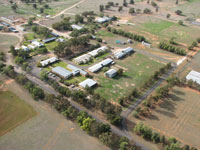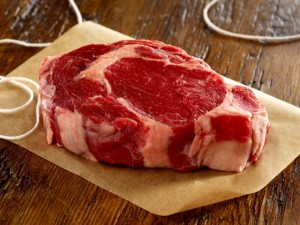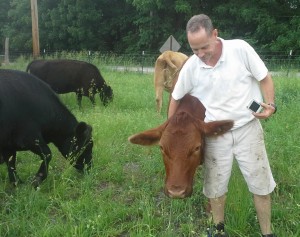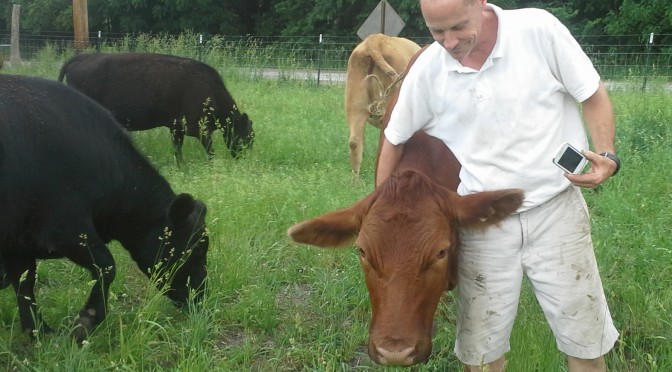Quality Control – Grass Fed Beef
Our goal at Full Sircle Farms is to produce the best quality grass fed beef available. Our tag line, “Sustainable Nutrition” describes our purpose. It begins with the best possible genetics. Lowline Angus.
Genetics
The research that led to the Lowline Angus breed began at the Trangie Research Center in Australia in 1929. From 1929-1964 Trangie acquired the best Aberdeen Angus from Canada, the USA, Scotland and New South Wales for the purpose of isolating superior genetic material. Lowlines are the direct descendants of the best prize-winning Angus blood-lines on the planet.

After 1974, the herd remained closed for 19 years, producing a new breed of cattle. Lowline Angus.
Lowlines were the result of over 64 years of effort that included selections for superior genetics, protein conversion efficiency and meat quality. The research culminated on August 8, 1992. That day seven Australian cattlemen met beneath a gum tree at the Trangie Center auction site, they bought the herd and formed the Australian Lowline Cattle Association. Pippa, the first fullblood heifer in America, arrived in North Dakota in July of 1996.
Lowline Quality
Lowlines are the direct descendants of prize-winning Angus blood-lines. This has produced an animal that is smaller in stature and carries prime beef qualities without having to be force fed corn in a confined feeding operation.

Lowlines have superior traits with 30% larger ribeye area per hundredweight than any other breed and they possess excellent marbling characteristics that are exhibited on grass alone. Lowline beef is superior in quality, with excellent taste, texture and tenderness. Our beef is naturally marbled without being excessive.
Smaller cattle have finer grained beef and finer grained beef is the most tender. This is due to the shorter cell muscular structure. They are, in general, 30% smaller than traditional breeds. Quality grass fed beef begins with genetics and ends with care.
Full Sircle Husbandry

Producing quality grass fed beef starts with excelent genetics and is then enhanced by management and careful attention to diet. To bring Lowline genetic qualities to their full potential we begin with the environment. That means we closely monitor soil conditions to provide the best quality grasses and legumes. Bromegrass, red clover, timothy, white clover, orchard grass and the occasional nettle balance the nutritional requirements for protein, vitamins and dry matter. Mineral supplements and the availability of clean drinking water is another key to providing the most nutritious beef possible. Our cattle are what they eat, and so are you.
Our cattle have always have access to grass and the natural environment as the health and happiness of the animal is foremost. Our cattle to live in a stress free environment as this has a direct correlation to the quality of the meat produced. As such we rotate the pastures regularly and we engage in low stress stock handling techniques. Our beef is hormone, antibiotic and GMO free.
Sustainable Nutrition
Lowlines are incredibly efficient convertors of grass to protein. Some Lowlines were found to be up to 100% more efficient than other breeds. A recent study on dairy cows concluded that with the right pasture and a winter feed, some farmers are seeing an 18-percent reduction in methane emissions. “If achieved nationwide, that kind of mitigation could account for almost three-quarters of the goal of reducing greenhouse gas emissions in the dairy industry 25 percent by 2020 (an agreement between the U.S. Department of Agriculture and the Innovation Center for U.S. Dairy)”
Lowlines possess the ability to produce nutrient dense protein and intramuscular fats called marbling.
Beef that is well marbled indicates that the monounsaturated to saturated fat ratio is higher. Fifty percent of all marbling is made up of oleic acid (mono-unsaturated), while a relatively small proportion is saturated fat.
Another benefit from marbling is derived from a particular component of the omega-6 polyunsaturated fatty acids, called conjugated linoleic acid (CLA). CLA has shown to have anti-carcinogenic (cancer forming) effects as well as being anti-inflammatory. It has a whole raft of health benefits such as reducing heart disease, diabetes and asthma to name a few.
Grass-fed cattle that are well marbled have the highest amount of CLA per gram due to higher linoleic acid levels. The concentration of CLA in fat is highest in pasture rather than grain fed cattle.

